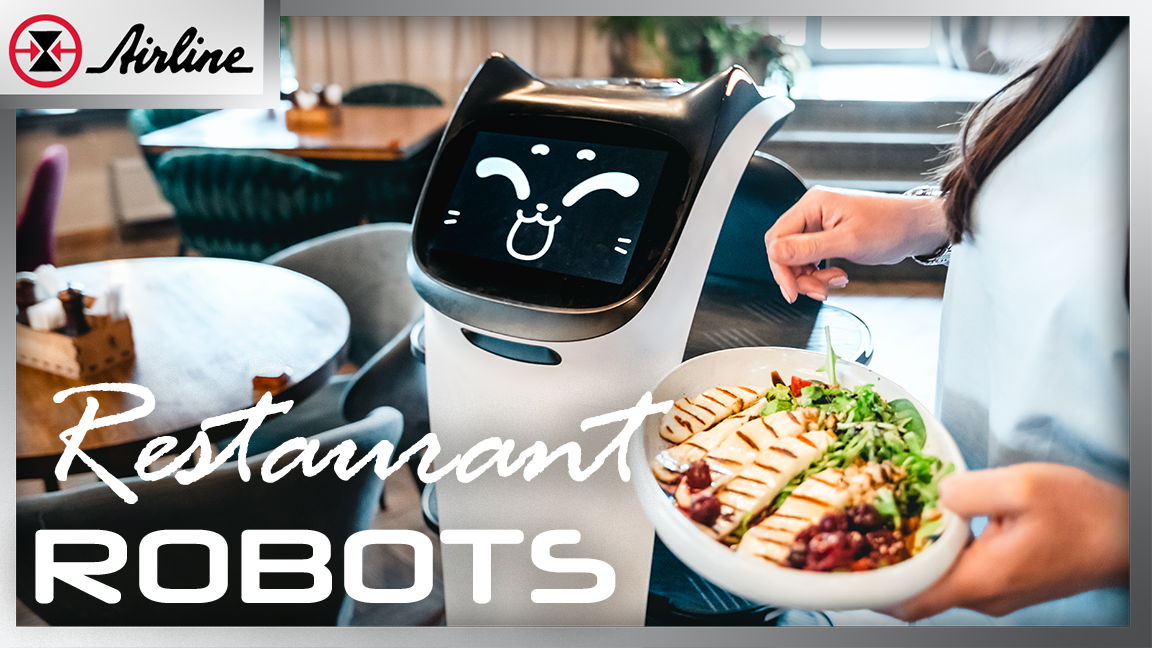Editor’s Note: This article was originally published in February 2024 and updated in June 2025 to reflect new data, examples, and trends in restaurant automation.
Seeing a robot deliver food is no longer something you’ll only find in tech hubs like San Francisco or Seattle. From trendy urban bistros to fast-food giants like Chick-fil-A and Burger King, robots in restaurants have become a familiar sight across the entire U.S., not just a trend but a growing part of everyday dining powered by restaurant automation.
What began as a way to stand out in a crowded market has evolved rapidly into a practical solution for ongoing labor shortages and the need for greater operational efficiency. The post-COVID shift toward contactless dining accelerated the adoption of automation technology. Much like QR code menus that became permanent fixtures, restaurant automation has stuck around, thanks to its speed, hygiene benefits, and efficient workflows.
Still, this robotic revolution isn’t without its complexities. The public’s sentiment remains mixed, with some diners embracing the innovation and others raising concerns about job displacement and the shrinking role of human connection in hospitality.
As more restaurants adopt automation technology, it's important to take a closer look at both the benefits and trade-offs that come with bringing robots into the dining experience, whether you're a restaurant owner, food tech enthusiast, or simply a curious customer.
In this article, we’ll explore how restaurant automation is being used today, its advantages and challenges, and what it all means for the future of the food service industry.
🤖 Watch Now: Cobot Safety Free Virtual Training
Advantages and Disadvantages of Restaurant Automation
Like any newer technology, restaurant robots have their own pros and cons. Let's review.
Advantages |
Disadvantages |
|
Efficiency and Productivity: Robots offer speed and precision, reducing waiting times. |
High Initial Investment: Purchasing and installing restaurant robots can be costly for small businesses. |
|
Consistency: Robots ensure consistent food quality and service. |
Maintenance Costs: Regular software updates and repairs can add up over time. |
|
Hygiene and Safety: Robots improve hygiene standards and reduce the risk of food contamination. |
Job Displacement: Restaurant robots could lead to job losses in the industry. |
|
Cost Savings: Over time, robots can reduce labor costs and waste. |
Customer Resistance: Some guests prefer human interaction over robotic service. |
|
Reduction In Human Error: Robots make fewer mistakes, enhancing the dining experience. |
Skill Gap: Staff may require training to operate and maintain the new technology, involving additional time and cost.
|
|
24/7 Service: Robots can work round the clock without breaks. |
Lack of Personal Touch: Robots can't provide the emotional connection or personalized service that human servers offer. |
Cost-Effectiveness and Efficiency
Adopting robots in restaurants can bring about substantial cost-effectiveness and efficiency. A great example of this is White Castle’s partnership with Miso Robotics. After piloting the original Flippy robot in a single location, White Castle saw an immediate improvement in daily operations and team productivity. That success led to the rollout of Flippy 2, an upgraded version of the burger-flipping robot, across 100 locations.
Flippy 2 takes over the work of an entire fry station, helping restaurants reduce labor strain while speeding up service. This improved kitchen workflow enables human staff to shift their focus toward customer-facing roles, ultimately creating a better overall experience. According to White Castle, the robot’s performance has already contributed to greater efficiency, product consistency, and team satisfaction.
While the initial investment in restaurant automation can seem significant, examples like this show that the long-term benefits, faster service, a more balanced workload, and cost savings make it a worthwhile consideration for restaurants looking to stay competitive.
Tackling Labor Shortages with Robots in Restaurants
Labor shortages in the restaurant and fast-food industries have eased slightly since the height of the pandemic, but the challenges haven’t gone away. According to the U.S. Bureau of Labor Statistics, as of March 2025, job openings in the accommodation and food services sector remain above pre-pandemic norms, with 858,000 openings reported, compared to the 2017–2019 average of 835,000. Despite a temporary hiring rebound, overall hiring remains weak, and quit rates continue to trend high, reaching a 13-month peak in March.

This means restaurants are still struggling to maintain a stable workforce. High turnover, rising labor costs, and difficulty filling key positions continue to impact daily operations. To mitigate this, restaurant automation offers a powerful way to offset these pressures.
By taking over repetitive and time-consuming tasks, such as running orders or preparing standardized meals, restaurant robots free up human staff to focus on higher-value responsibilities, including customer engagement, personalization, and problem-solving. This doesn't mean replacing humans. It means using automation to build a more stable, resilient, and scalable operation.
With the labor market slowly normalizing but not yet fully balanced, robots in restaurants provide a strategic advantage: consistency, 24/7 availability, and cost efficiency in a workforce environment that’s anything but predictable.
Ethical Considerations of Robots in Restaurants
But while robots may ease the burden of understaffed kitchens, they also raise important ethical questions about employment, equity, and the very essence of hospitality.
As automation becomes more widespread, it’s essential to examine these concerns thoughtfully and ensure that the integration of technology is both responsible and humane.
🤔 What do you think? We’d love to hear your thoughts in the comments below.

Job Displacement
The most significant ethical concern is job displacement due to automation. The restaurant sector is a major source of employment, particularly for restaurant workers with less education opportunities. Automating tasks traditionally done by humans could lead to job losses, affecting livelihoods and potentially exacerbating socio-economic inequality.
Fair Distribution of Benefits
The benefits of automation, efficiency, cost savings, and increased profits, mainly accrue to businesses and consumers. However, displaced workers may not share these gains. This raises the question of equity and the fair distribution of benefits.
Dependence on Technology
Over-reliance on robots could make businesses vulnerable to technological failures and cyber threats. Any service disruption could impact business operations and customer satisfaction.
Privacy and Data Security
Robotic servers may collect and process extensive amounts of customer data, raising privacy concerns. Restaurants must ensure they adhere to data protection laws and respect customer privacy.
Human Interaction
An ethical aspect often overlooked is the value of human interaction in hospitality. Robots lack the capacity for empathy, emotional responsiveness, and personal touch that human servers provide. The shift towards automation could potentially degrade the dining experience and human connection integral to any hospitality business.
How Restaurant Robots Affect the Customer Experience
 Ethical questions give us big-picture concerns, but on the ground, it all comes down to how customers feel. Do diners enjoy robotic service, or does it leave something to be desired? The impact of robot technology on customer experience varies.
Ethical questions give us big-picture concerns, but on the ground, it all comes down to how customers feel. Do diners enjoy robotic service, or does it leave something to be desired? The impact of robot technology on customer experience varies.
For some, the novelty and efficiency of robotic service enhance the dining experience. A survey by Software Advice found that 61% of consumers agreed that they would like to see more technology used in food service, indicating a positive reception towards the use of technology like restaurant robots.
However, the absence of human touch can be a downside for others. According to a study by Harvard Business School, customers who received service from a human server rated their experience 15% higher than those who used self-service technology. This suggests that while robots can bring efficiency and novelty, they may not entirely replace the warmth and personalized service offered by human servers.
Restaurant Robots in Action: Case Studies of Success and Failure
Exploring some real-world examples can help you better understand the impact of restaurant robots' successes and where they still fall short.
Success Stories in Restaurant Automation: Robots Elevating the Customer Experience

Sweetgreen's infinite kitchen system
One standout example is Sweetgreen, the fast-casual restaurant chain that focuses on serving fresh, seasonal, and healthy food, primarily salads. This restaurant has implemented robotic automation in some of its locations, particularly in what it calls the "Infinite Kitchen." This system utilizes robotic arms and dispensing tubes to assemble salads on a conveyor belt, significantly enhancing efficiency and consistency. At peak performance, some locations can produce up to 500 bowls per hour. While automation handles most of the assembly process, human employees still play a crucial role in tasks like stocking ingredients, adding final touches, and ensuring customer satisfaction. This hybrid model underscores how automation can enhance throughput while preserving the human elements essential to hospitality.
Another success can be seen in the fast food giant, McDonald's, which implemented self-service kiosks for ordering meals in many of its locations. These kiosks have significantly reduced the waiting time for customers, leading to a 5-6% increase in sales in the first year of their introduction. Simultaneously, using kiosks has freed employees to focus more on improving customer service, thus positively impacting the dining experience.
Challenges: When Restaurant Robots Fall Short
On the flip side, there are instances where the implementation of robots in restaurants did not meet expectations. One such case happened at Zume Pizza, a Silicon Valley startup that used robots to prepare pizzas. Zume initially drew attention due to its unique concept of automated pizza preparation and delivery. However, the company had to lay off over half its workforce by early 2020, citing its inability to scale the business and secure additional funding.
Similarly, Chowbotics, a company known for its robotic salad-making kiosk, ‘Sally’, faced challenges in maintaining customer interest. While the initial novelty of a salad-making robot attracted customers, Sally’s inability to provide a personalized touch that a human chef could offer became evident over time. The company, after a couple of years of operation, had to pivot to using Sally in hotels and convenience stores rather than restaurants.
Humans Still Matter: Balancing Automation with Soft Skills

Why People Still Outperform Robots
Despite the rising popularity of robots in restaurants, human staff remain irreplaceable in many critical ways. While automation handles repetitive, high-volume tasks with precision, people bring something robots still can’t replicate: emotional intelligence, adaptability, and human connection.
Servers, hosts, and kitchen staff are often called on to read subtle cues, respond to real-time challenges, and create memorable experiences that go beyond efficiency. A human can comfort an unhappy guest, accommodate a unique allergy request, or build customer loyalty through meaningful interaction—tasks that robots simply aren’t equipped to handle.
Even the most advanced restaurant technology works best as a supporting role, not a total replacement. Automation thrives when paired with people who know how to make the technology work smarter and smoother in dynamic environments.
Upskilling for a Collaborative Future
As robots take on more tasks in food prep, delivery, and ordering, staff training is more important than ever. Employees need new skills to operate, monitor, and troubleshoot automated systems. But upskilling isn’t just about technical know-how; it’s also about learning how to work alongside automation.
Forward-thinking restaurants are already investing in cross-training programs that teach both robot operation and interpersonal service skills, empowering their teams to shift into higher-value roles. These programs often focus on:
- Operating and maintaining service robots
- Monitoring system performance
- Troubleshooting errors and minimizing downtime
- Enhancing customer experience with tech-assisted service
Restaurants that foster a culture of continuous learning not only improve tech adoption but also boost team morale. When staff are trained and trusted to lead the human side of the operation, they become collaborators in innovation, not casualties of it.
💡 Airline offers custom training to help you integrate automation smoothly and empower your team; just reach out to learn more.
The Future of Restaurant Automation and Robotics
Advancements in AI and machine learning, along with ethical considerations about labor and customer interactions, are likely to shape the future of restaurant robots. These factors will be crucial in adopting and integrating robot technology into the restaurant industry in the coming years.
AI and Machine Learning
AI and machine learning are set to influence the future of restaurant robots significantly. These technologies empower robots to:
- Automate repetitive tasks, thereby improving their efficiency and precision
- Learn, reason, and perceive, which allows them to analyze data, make predictions, and adjust their behavior.
- Recognize objects and ingredients.
- Personalize interactions with customers.
This technological advancement, supported by the National Restaurant Association, will revolutionize the capabilities of restaurant robots.
These applications contribute to streamlining operations and enhancing profitability. For instance, machine learning is utilized in restaurant robotics to instruct robots in cooking, matching customers to restaurants based on their preferences, and identifying the contents of food at a molecular level.
Last Thoughts
Robots are absolutely transforming the restaurant industry, bringing incredible efficiency and cost-effectiveness. Of course, there are a few challenges to overcome like initial costs and maintenance, but hey, nothing worth having comes easy. The secret to success lies in finding the perfect balance between our trusty robots and our amazing human staff, creating an unforgettable, efficient, and budget-friendly dining experience that will leave you wanting more.
Need help implementing robots? We are here to help.
Additional Resources
Webinar: Instantly watch the Cobot Safety Training + Q&A
Webinar: Taking the Leap Into Industrial Robotics








Leave Comment